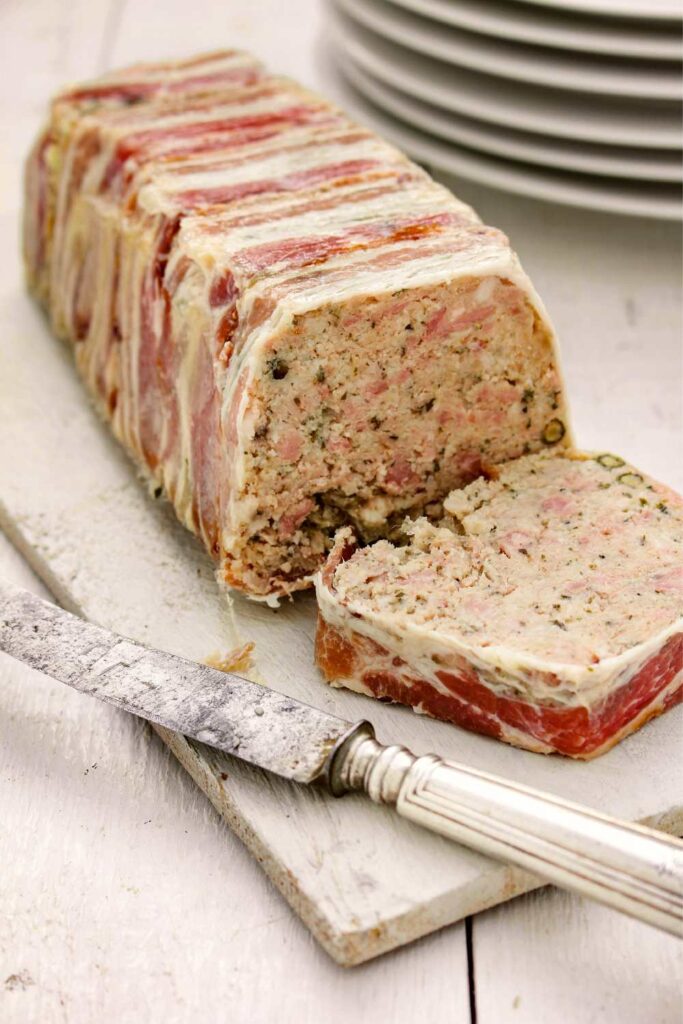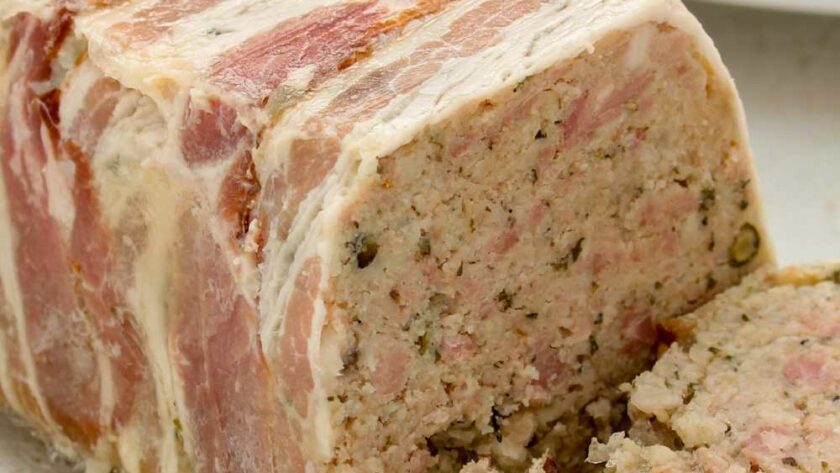Right—let’s just say this up front: terrines look fancier than they are. The first time I attempted Mary Berry’s Ham Hock Terrine, I treated it like some delicate relic from a French château. I hovered over it. I second-guessed every herb. And do you know what I ended up with? A jiggly mess that wouldn’t slice properly and tasted like pickled confusion.
But here’s the thing—it wasn’t the terrine’s fault. It was mine. I rushed. I didn’t let the stock reduce enough. I overthought it. Fast forward a few attempts later (and yes, some choice words muttered in the kitchen), I finally cracked it.
This version? It’s what Mary intended: rich, salty, fresh with herbs, slightly sharp from the vinegar and gherkins, and firm enough to slice into glistening segments that do look terribly posh at a party. The ham hock terrine is a traditional British showstopper—if you give it the time and respect it quietly demands.
Ingredients List
- 3 ham hocks on the bone — soaked overnight; gives deep, savoury flavour.
- 2 bay leaves
- 4 fresh thyme sprigs — earthiness that cuts through the fat beautifully.
- 1 tsp coriander seeds — a citrusy lift that keeps it from feeling too heavy.
- 1 tsp black peppercorns
- 1 large onion, quartered
- 4 tbsp white wine vinegar — this sharpness balances the richness.
- 50g gherkins, finely chopped — adds brightness and crunch.
- Large handful of fresh flat-leaf parsley, chopped
- Few sprigs of fresh tarragon, chopped — just enough to intrigue.
How To Make It (Instructions)
- In a large, heavy-bottomed pot, throw in the ham hocks, bay leaves, thyme, coriander, peppercorns, onion, and vinegar. Cover with cold water.
- Bring to a gentle boil, then reduce to the quietest simmer. Leave it alone for 2 to 2½ hours, until the meat is practically falling off the bone.
- Turn off the heat, and let the hocks sit in their spa-like broth for about an hour. Use this time to do the washing up—or more realistically, scroll through your phone with a cup of tea.
- Remove the hocks. Strain the liquid (say goodbye to the mushy aromatics), and put the broth back on the hob. Boil it hard for about an hour until reduced to about 600ml. Don’t wander off—this reduction step matters. I once ignored it and ended up with watery regret.
- Line a 1.5L loaf tin or terrine mould with clingfilm—two layers. Trust me, it makes unmoulding much less dramatic later.
- Peel the skin off the ham, and shred the meat into generous chunks. In a big bowl, mix the ham with the parsley, tarragon, and chopped gherkins. Season with black pepper. Don’t add salt yet. Taste it first—the hocks are salty enough.
- Pack the mixture tightly into the lined mould. Press it down well—it should feel dense, not loose.
- Slowly pour the reduced stock over the top. Let it settle and seep in.
- Cover with more clingfilm. Chill overnight—at least 6 hours, but ideally 12.
- When ready, slice thick and serve with crusty bread and a good, tangy piccalilli. Or eat it standing by the fridge with a fork. I won’t tell.

Common Mistakes
Why didn’t my terrine set properly?
You likely didn’t reduce the stock enough. That gelatin from the hocks needs to concentrate to firm up when cold.
Why is it too salty?
Ham hocks are naturally salty. Always taste the shredded meat before seasoning. I’ve overdone it myself—then had to serve it with extra gherkins just to distract from the salt.
Why is my terrine falling apart when sliced?
It wasn’t pressed tightly enough or didn’t chill long enough. Give it time and compression.
Can I just use chicken or bacon instead?
Technically yes, but it won’t taste like a proper ham hock terrine. Hocks have collagen that helps it set naturally.
What’s with the air bubbles?
Tap the mould gently on the counter to release any trapped air before chilling.
Storage and Reheating Tips
Fridge:
Keep tightly wrapped in clingfilm or foil. It lasts up to 3 days.
Freezer:
Wrap in several layers of clingfilm and freeze for up to 3 months. Thaw overnight in the fridge.
Reheating (if serving warm):
- Oven: Cover slices with foil, bake at 175°C (350°F) for 10–15 mins.
- Microwave: Medium power, 30 seconds per slice.
- Stovetop: Non-stick pan, low heat, flip occasionally.
Though frankly, I prefer it cold.
What To Serve With It
- Crusty sourdough or baguette – for contrast and crunch.
- Sharp English mustard or piccalilli – zingy and tangy against the rich meat.
- Light green salad – I often throw in fennel or celery to add freshness.
Oh, and a dry white wine or a chilled cider doesn’t hurt either.
FAQ Section
Can I make this terrine gluten-free?
Yes—none of the ingredients contain gluten, just be sure to serve it with gluten-free bread or crackers.
What’s the best way to slice the terrine?
Use a sharp knife dipped in hot water, then wiped dry. Makes for clean, tidy slices.
Can I add vegetables to the mix?
Small additions like diced carrots or leeks can work, but don’t overwhelm the ham. Keep it subtle.
Do I have to use a terrine mould?
Nope. A regular loaf tin works just fine—just line it well with clingfilm for easy removal.
Try More Recipes:

Mary Berry Ham Hock Terrine
Description
A classic British terrine made with tender ham hock, fresh herbs, and gherkins—perfect for slicing and sharing.
Ingredients
Instructions
- Slice and serve cold, garnished with fresh herbs.
- In a large pot, combine ham hocks, herbs, spices, onion, and vinegar. Cover with water.
- Bring to boil, then simmer gently uncovered for 2–2½ hours.
- Cool the hocks in the liquid for 1 hour.
- Remove hocks; strain the liquid. Boil the broth for 1 hour until reduced to ~600ml.
- Line a 1.5L loaf tin with two layers of clingfilm.
- Remove skin, shred meat, mix with gherkins and herbs. Season to taste.
- Press into tin firmly.
- Pour reduced stock over, let it settle.
- Cover and refrigerate overnight.

